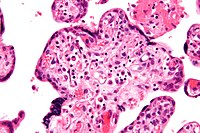
Photo from wikipedia
Abstract Background: To investigate the characteristics and risk factors for extrauterine growth retardation (EUGR) in very-low-birth-weight infants (VLBWIs). Methods: The medical records of 137 VLBWIs admitted to the neonatal intensive… Click to show full abstract
Abstract Background: To investigate the characteristics and risk factors for extrauterine growth retardation (EUGR) in very-low-birth-weight infants (VLBWIs). Methods: The medical records of 137 VLBWIs admitted to the neonatal intensive care unit between June 2015 and December 2017 were retrospectively reviewed. The patients were divided into EUGR (n = 92) and non-EUGR (n = 45) groups. This study collected data on demographic and clinical characteristics and analyzed the risk factors for EUGR with multivariate logistic regression. Results: Gestational age (OR = 0.573, P < .01), SGA (OR = 3.887, P = .022), feeding intolerance (OR = 4.632, P = .002), and calories supplied by amino acids at the 7th day (OR = 0.786, P = .006) were high-risk factors for EUGR. Conclusion: Feeding intolerance reduction and amino acid nutrition support should be applied to prevent delayed extrauterine growth for VLBWIs.
Journal Title: Medicine
Year Published: 2020
Link to full text (if available)
Share on Social Media: Sign Up to like & get
recommendations!